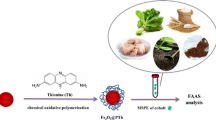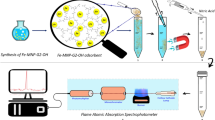Abstract
Baby food safety is an essential issue in health policy. For this reason, a simple, cheap, and fast analytical procedure to developed arsenic(III) and total arsenic determination in baby food samples using functionalized magnetic graphane oxide nanocomposite. A new nanocomposite anchored of tiopronin (TSH) magnetic graphane oxide (GO–PG4@Fe3O4-TSH) was first synthesized/characterized and used as an adsorbent to determine arsenic(III) and total arsenic for baby food samples. Arsenic(III) was directly determined on GO–PG4@Fe3O4-TSH nanocomposite at pH 4.5. The determination of total arsenic used KI and L( +) ascorbic acid solution as reducing reagents. The parameters influential on arsenic(III) determination in the baby food samples including the sample’s pH, adsorption time, amount of GO–PG4@Fe3O4-TSH, eluent type, sample volume, reducing reagent type and amount, and also foreign ion effect were investigated. The GO–PG4@Fe3O4-TSH carrying As(III) could easily be separated from baby food samples via applying an external magnetic field. The detection limit for arsenic(III) was found as 0.11 μg L−1, while the limit of quantification values was computed as 0.37 μg L−1. The precision of results, expressed as relative standard deviation, was always lower than 1.6% at 1 mg L−1 As(III) levels. The accuracy of this method was confirmed by analysis of certified reference material. The method was successively applied to determine arsenic(III) and total arsenic in baby food samples.






Similar content being viewed by others
References
Kalal HS, Khanchi AR, Konoz E, Khaki S, Taghiof M, Baghdadi M, Panahi HA (2012) Preconcentration of ultra-trace furan in beverage samples and its determination by high performance liquid cromatography. Int J Indust Chem 3:1–6
Nebota C, Guarddon M, Seco F, Iglesias A, Miranda JM, Franco CM, Cepeda A (2014) Monitoring the presence of residues of tetracyclines in baby food samples by HPLC-MS/MS. Food Control 46:495–501
Chen CJ, Wang CJ (1990) Ecological correlation between arsenic level in well water and age-adjusted mortality from malignant neoplasms. Cancer Res 50:5470–5474
Brown J, Kitchin K, Carcinog T, George M (1997) Dimethylarsinic acid treatment alters six different rat biochemical parameters: relevance to arsenic carcinogenesis. Teratog Carcinog Mutagen 17:71–84
Shirley S, Tao H, Bolger PM (1999) Dietary arsenic intakes in the United States: FDA Total Diet Study. September 1991-December 1996. Food Addit Contam 16:465–472
Gallagher P, Wei X, Shoemaker JA, Brockhoff CA, Creed JT (1999) Detection of arsenosugars from kelp extracts via IC-electrospray ionization-MS-MS and IC membrane hydride generation ICP-MS. J Anal At Spectrom 14:1829–1834
Burguera M, Burguera JL (1997) Analytical methodology for speciation of arsenic in environmental and biological samples. Talanta 44:1581–1604
Yan XP, Yin XB, He XW, Jiang Y (2002) Flow injection on-line sorption preconcentration coupled with hydride generation atomic fluorescence spectrometry for determination of (ultra)trace amounts of arsenic(III) and arsenic(V) in Natural Water Samples. Anal Chem 74:2162–2166
Smedley PL, Kinniburgh DG (2002) A review of the source, behaviour and distribution of arsenic in natural waters. Appl Geochem 17:517–568
Benramdane L, Bressolle F, Vallon JJ (1999) Arsenic speciation in humans and food products: a review. J Chromatogr Sci 37:330–344
Seiler HG, Sigel A, Sigel H (1994) Handbook on metals in clinical and analytical chemistry. Marcel Dekker, New York, p 237
Dabeka RW, McKenzie AD, Lacroix GMA, Cleroux C, Bowe S, Graham RA, Conacher HBS, Verdier P (1993) Survey of arsenic in total diet food composites and estimation of the dietary intake of arsenic by canadian adults and children. J AOAC Int 76:14–25
Smith AH, Arroyo AP, Mazumder DN, Kosnett MJ, Hernandez AL, Beeris M, Smith MM, Moore LE (2000) Arsenic-induced skin lesions among Atacameño people in Northern Chile despite good nutrition and centuries of exposure. Environ Health Perspect 108:617–620
Pesch B, Ranft U, Jakubis P, Nieuwenhuijsen MJ, Hergemöller A, Unfried K, Jakubis M, Miskovic P, Keegan T (2002) Environmental arsenic exposure from a coal-burning power plant as a potential risk factor for nonmelanoma skin carcinoma: results from a case-control study in the district of prievidza Slovakia. Am J Epidem 155:798–809
Concon JM (1988) Inorganic and organometallic contaminants in food-stuffs. Food Toxicology Part B: Contaminants and Additives (New York: Marcel Dekker). 1033–1132
Larsen EH, Pritzl G, Hansen SH (1993) Arsenic speciation in seafood samples with emphasis on minor constituents: an investigation using high-performance liquid chromatography with detection by inductively coupled plasma mass spectrometry. J Analy A Spect 8:1075–1084
Heitkemper DT, Vela NP, Stewart KR, Westphal CS (2001) Determination of total and speciated arsenic in rice by ion chromatography and inductively coupled plasma mass spectrometry. J Anal At Spectrom 16:299–306
Satienperakul S, Cardwell TJ, Kolev SD, Lenehan CE, Barnett NW (2005) A sensitive procedure for the rapid determination of arsenic(III) byflow injection analysis and chemiluminescence detection. Analy Chim Acta 554:25–30
Yang G, Xu J, Zheng J, Xu X, Wang W, Xu L, Chen G, Fu F (2009) Speciation analysis of arsenic in Mya arenaria Linnaeus and Shrimp with capillary electrophoresis-inductively coupled plasma mass spectrometry. Talanta 78:471–476
Tuzen M, Saygı KO, Karaman I, Soylak M (2010) Selective speciation and determination of inorganic arsenic in water, food and biological samples. Food and Chem Tox 48:41–46
Öksüz N, Saçmacı Ş, Saçmacı M, Ulgen A (2019) A new fluorescence reagent: Synthesis, characterization and application for speciation of arsenic (III)/(VI) species in tea samples. Food Chem 270:579–584
Koh J, Kwon Y, Pak YN (2005) Separation and sensitive determination of arsenic species (As3+/As5+) using the yeast-immobilized column and hydride generation in ICP–AES. Microchem J 80:195–199
Jackson BP, Bertsch PM (2001) Determination of arsenic speciation in poultry wastes by IC-ICP-MS. Environ Sci Technol 35:4868–4873
Yang X, Zhang X, Liu Z, Ma Y, Huang Y, Chen Y (2008) High-efficiency loading and controlled release of doxorubicin hydrochloride on graphene oxide. J Phys Chem 112:17554–17558
Liu Z, Robinson JT, Sun X, Dai H (2008) PEGylated nanographene oxide for delivery of water-insoluble cancer drugs. J Am Chem Soc 130:10876–10877
Wate PS, Banerjee SS, Archana JB, Mascarenhas RR, Zope KR, Khandare J, Misra RD (2012) Cellular imaging using biocompatible dendrimer-functionalized graphene oxide-based fluorescent probe anchored with magnetic nanoparticles. Nanotechnology 23:1–8
Banerjee SS, Chen D (2007) Magnetic nanoparticles grafted with cyclodextrin for hydrophobic drug delivery. Chem Mater 19:6345–6349
Saçmacı Ş, Saçmacı M, Kök C (2018) Grafting of glutathione to magnetic graphene oxide and application for the determination of As(III)/(V) in food samples via a zeta potential analyzer. New J Chem 42:5345–5355
Ferrari AC, Robertson J (2000) Interpretation of raman spectra of disordered and amorphous carbon. Phys Rev B 61:14095–14107
Liu YQ, Gao L, Sun J, Wang Y, Zhang J (2009) Stable nafionfunctionalized graphene dispersions for transparent conducting films. Nanotechnology 20:465–605
Alwarappan S, Erdem A, Liu C, Li CZ (2009) Probing the electrochemical properties of graphene nanosheets for biosensing applications. J Phys Chem C 113:8853–8857
Funding
The authors are grateful for the financial support provided by the Unit of Scientific Research Projects of Yozgat Bozok University, Turkey (Project No: 6602c-FEN/19–269).
Author information
Authors and Affiliations
Corresponding author
Ethics declarations
Ethics Approval
This research did not contain any studies involving human or animal subjects.
Competing Interests
The authors declare no competing interests.
Additional information
Publisher’s Note
Springer Nature remains neutral with regard to jurisdictional claims in published maps and institutional affiliations.
Rights and permissions
About this article
Cite this article
Saçmacı, Ş., Saçmacı, M. Determination of Arsenic(III) and Total Arsenic at Trace Levels in Baby Food Samples via a New Functionalized Magnetic Graphane Oxide Nanocomposite . Biol Trace Elem Res 199, 4856–4866 (2021). https://doi.org/10.1007/s12011-021-02754-7
Received:
Accepted:
Published:
Issue Date:
DOI: https://doi.org/10.1007/s12011-021-02754-7




